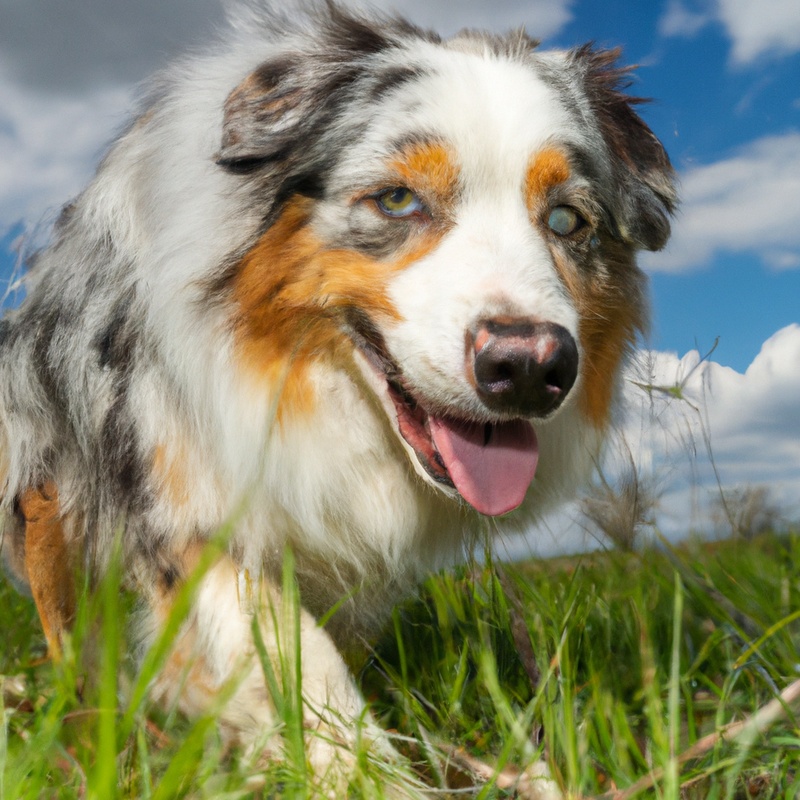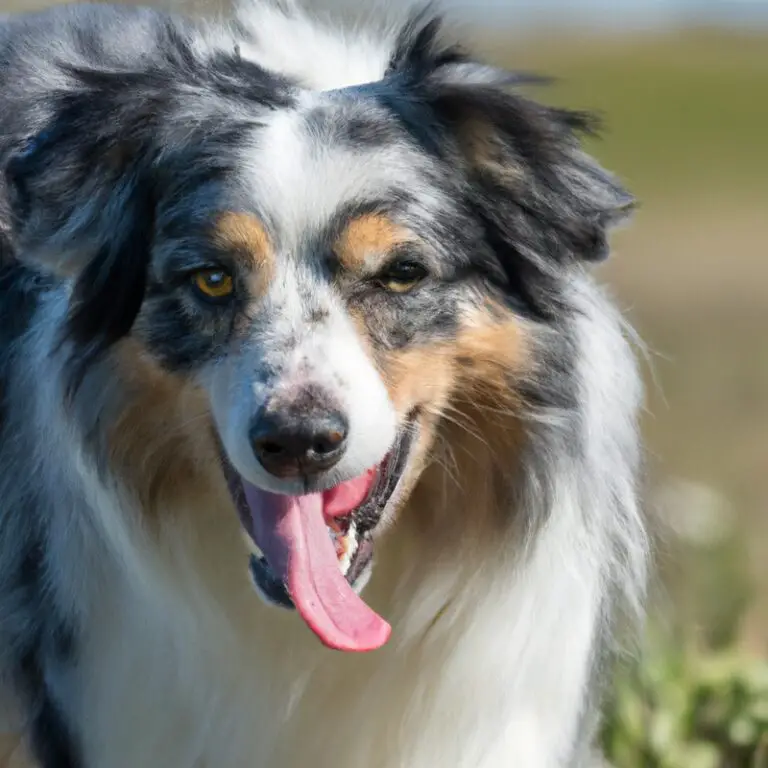How Do Australian Shepherds Behave Around Livestock?
Key Takeaways:
- Australian Shepherds demonstrate a natural herding instinct around livestock.
- They are known for their intelligence and ability to adapt to different livestock handling methods.
- Australian Shepherds require proper training and socialization to excel in herding tasks.
- The breed may exhibit different behaviors depending on the individual dog and specific livestock they are working with.
Australian Shepherds and livestock share a unique and fascinating connection, one that showcases the incredible capabilities of these remarkable working dogs. As an expert in the field, I’m here to shed light on the typical behavior of Australian Shepherds when it comes to livestock.
We’ll explore their innate herding instincts, their remarkable communication skills, and their ability to adapt to different livestock species.
Furthermore, I’ll provide insights into training techniques and tips for maintaining good behavior in these intelligent and energetic canines. Join me on this informative journey into the world of Australian Shepherds and their interactions with livestock!
| Behavior | Description |
|---|---|
| Instinctual | Australian Shepherds have a strong instinct to herd livestock, which means they may try to round up and control the movements of animals. |
| Active | They are highly energetic and active dogs, which makes them well-suited for working with livestock. They have the stamina to keep up with the demands of herding. |
| Alert | Aussies are known for their alertness and awareness of their surroundings. They will be quick to detect any changes in the behavior or movement of livestock. |
| Responsive | They respond well to commands and guidance from their handlers. They can quickly adjust their behavior to meet the needs of the livestock and work as a team. |
| Protective | Australian Shepherds naturally feel protective towards their herd and will go to great lengths to keep them safe from any potential threats. |
| Independent | While they are responsive to commands, Australian Shepherds also have an independent streak. They can make decisions on their own when herding livestock. |
| Gentle | Despite their herding instincts, Australian Shepherds are generally gentle and patient with livestock. They use their body language and nipping to guide the animals. |
Australian Shepherds and Livestock: A Natural Connection
Australian Shepherds as Working Dogs
Australian Shepherds are highly regarded as working dogs due to their exceptional skills and natural instincts. They excel in various tasks such as herding livestock, guarding property, and performing search and rescue missions.
They are known for their intelligence, agility, and strong work ethic.
Whether it’s in a ranch, farm, or any other working environment, Australian Shepherds are dependable and reliable partners. With proper training and socialization, they can fulfill their working duties effectively and efficiently.
Their versatility and adaptability make them excellent working companions in various settings.
Understanding the Herding Instinct
Understanding the Herding Instinct: The herding instinct is an innate behavior in Australian Shepherds, passed down from their ancestors who were bred for herding livestock. This instinct drives them to gather and move animals, including livestock, in a controlled manner.
They use a combination of body language, eye contact, and vocal signals to communicate their intentions to the livestock.
It’s important to understand that herding behavior in Australian Shepherds is not aggressive or predatory. It stems from a natural desire to control and guide the animals.
Australian Shepherds may exhibit behaviors such as circling, crouching, nipping at heels, or barking to gather and move livestock.
When it comes to understanding the herding instinct, it is crucial to recognize that it can vary in intensity among individual dogs. Some Australian Shepherds have a strong herding instinct and may require more training and guidance, while others may have a more moderate instinct.
To nurture and channel the herding instinct in a positive way, it is essential for Australian Shepherds to receive proper training and socialization from a young age.
This includes exposing them to different types of livestock and teaching them commands and cues for herding tasks. Remember, understanding and respecting the herding instinct in Australian Shepherds is key to effectively working with them around livestock.
With patience, consistency, and appropriate training, these intelligent dogs can excel in herding and create a harmonious connection with the animals they work with.

The Relationship Between Australian Shepherds and Livestock
Australian Shepherds have a strong and natural relationship with livestock. They are known for their herding abilities and are often used as working dogs on farms and ranches.
Australian Shepherds have a natural instinct to gather and move livestock, making them valuable assets in herding and managing animals.
They have an innate understanding of how to communicate with livestock, using various signals and verbal commands. Australian Shepherds can adapt to different livestock species and are capable of working with cattle, sheep, horses, and other animals.
The bond between Australian Shepherds and livestock is built on trust and mutual respect, with the dogs demonstrating their loyalty and dedication to their work.
Their ability to handle livestock makes them well-suited for tasks such as gathering, sorting, and guarding animals. Australian Shepherds excel in their role as working dogs and form a strong partnership with the livestock they interact with.
Typical Behavior of Australian Shepherds Around Livestock
Herding Behavior: Gathering and Moving Livestock
Australian Shepherds have a natural herding instinct that makes them excellent at gathering and moving livestock. When it comes to herding behavior, these dogs display several key characteristics.
First, Australian Shepherds use their eyes to “eye” the livestock, maintaining a steady gaze to control their movement.
They typically crouch and move in a stalking manner, which helps create a sense of authority and confidence among the livestock. Second, Australian Shepherds use their natural athleticism and agility to quickly maneuver around the livestock, guiding them in the desired direction.
Their speed and nimbleness allow them to change direction swiftly and respond to any changes in the livestock’s behavior.
Third, Australian Shepherds use both verbal and non-verbal cues to communicate with the livestock. They may use barks, growls, or whistles to give signals and establish their authority.
Additionally, they may use body movements, such as nipping at the heels or shoulders of the livestock, to encourage them to move in a specific way.
It’s important to note that herding behavior can vary depending on the specific livestock species. Australian Shepherds may adjust their approach based on whether they are herding sheep, cattle, or other animals.
Each species may require different techniques and strategies to effectively gather and move them.
Communication Signals and Verbal Commands
When it comes to communicating with Australian Shepherds around livestock, there are some key signals and commands to keep in mind. These can help you effectively guide and control your dog during herding activities.
For communication signals, body language plays a crucial role.
Dogs are highly attuned to human body language, so it’s important to use clear and consistent signals. For example, using a pointing gesture or where you direct your gaze can indicate the desired direction for your Australian Shepherd to move the livestock.
Verbal commands are another way to communicate with your dog.
Australian Shepherds are known for their responsiveness to verbal cues. Common commands for herding include “Come-by” (to move clockwise around the livestock) and “Away” (to move counterclockwise).
Additionally, using commands like “Steady” (to slow down) and “Wait” (to pause) can help maintain control during herding tasks.
Consistency and positive reinforcement are key when using verbal commands. Overall, effective communication signals and verbal commands are essential for successfully working with Australian Shepherds around livestock.
By using clear body language and practicing consistent verbal cues, you can establish a strong understanding between you and your dog, making herding activities more enjoyable and productive.
Responding to Different Livestock Species
When it comes to responding to different livestock species, Australian Shepherds have a natural instinct and ability to adapt. They possess the intelligence and agility to work with various types of livestock, including cattle, sheep, goats, and even poultry.
When interacting with cattle, Australian Shepherds are known for their calm demeanor and gentle yet assertive herding techniques.
They use their natural herding instincts to gather the cattle into a group and gently guide them in the desired direction. Australian Shepherds are capable of adapting their behavior to the size and temperament of the cattle they are working with.
With sheep, Australian Shepherds display a more high-energy and agile approach.
They use their quick movements and loud command signals to control the flock and prevent any dispersal. Australian Shepherds are also adept at navigating the rough terrain often found in sheep pastures.
When working with goats, Australian Shepherds need to be patient and understanding.
Goats can be independent and stubborn, so the Australian Shepherd’s ability to communicate and establish trust with the goats is essential. Australian Shepherds use their herding instincts and command signals to guide and corral the goats effectively.
Although Australian Shepherds are not traditional livestock guardians like certain breeds, they can still adapt to working with poultry.
They understand the need for gentleness around smaller animals and can help guide and protect the poultry within their designated area.
Training Australian Shepherds to Behave Around Livestock
Obedience Training Techniques

Socialization with Livestock
When it comes to socializing Australian Shepherds with livestock, it’s important to start early and introduce them to different types of animals. This helps them become familiar and comfortable around livestock.
Another important aspect is teaching them appropriate behavior around livestock.
This includes not chasing or nipping at them, but rather respecting their space and boundaries. Positive reinforcement training methods, such as reward-based training, can be highly effective in teaching Australian Shepherds to behave calmly and respectfully around livestock.
It’s also essential to supervise their interactions with livestock until you are confident in their behavior.
This ensures both the safety of the animals and your Australian Shepherd. Overall, with proper socialization and training, Australian Shepherds can develop a positive and cooperative relationship with livestock.

Advanced Training for Working Australian Shepherds
When it comes to advanced training for working Australian Shepherds, there are a few key aspects to focus on. Firstly, it’s important to continue building on the foundation of basic obedience training.
This includes commands such as sit, stay, come, and heel.
By reinforcing these commands, you can ensure that your Australian Shepherd reliably follows your instructions while working with livestock. Another crucial aspect of advanced training is teaching your Australian Shepherd advanced herding techniques.
This involves honing their natural herding instincts and teaching them how to effectively gather and move livestock.
Using verbal commands and body language, you can communicate with your dog and direct their actions around the livestock. In addition to obedience and herding training, it’s important to expose your Australian Shepherd to a variety of livestock species.
This can help them become familiar with different behaviors and develop proper responses.
By gradually introducing your dog to different livestock, you can help them become more comfortable and less anxious in their presence. Advanced training for working Australian Shepherds also involves proper socialization with livestock.
This means allowing your dog to interact with the animals in a controlled setting.
This can help them establish a positive and respectful relationship with the livestock. It’s important to monitor their interactions and intervene if any unwanted behaviors arise.
Maintaining focus and attention is another key aspect of advanced training.
Australian Shepherds are intelligent and energetic dogs, so providing mental stimulation is crucial. Incorporating tasks and exercises that challenge their problem-solving abilities can help keep them engaged and focused on the task at hand.
Challenges and Tips for Maintaining Good Behavior
Boundary Setting and Preventing Chasing
Boundary setting is a crucial aspect of training Australian Shepherds around livestock. It helps prevent them from chasing or herding the animals in an uncontrolled manner.
One effective way to establish boundaries is through physical barriers such as fences or gates.
These physical boundaries create a clear separation between the Australian Shepherd and the livestock, reducing the chances of chasing incidents. In addition to physical boundaries, it’s important to set clear verbal boundaries as well.
This involves teaching the Australian Shepherd specific commands to signal when it’s appropriate to approach, interact with, or move the livestock.
Consistency is key, so using the same commands and signals each time helps the dog understand what is expected of them. Positive reinforcement is another powerful tool in boundary setting.
Rewarding the Australian Shepherd for staying calm and not chasing the livestock helps reinforce the desired behavior.
Treats, praise, or play can be used as rewards to motivate and reinforce the idea that staying within the designated boundaries is rewarding. Regular exercise and mental stimulation can also help prevent chasing behavior.
Providing the Australian Shepherd with enough physical and mental stimulation throughout the day helps minimize their drive to chase or herd livestock out of boredom or excess energy.
Remember, every Australian Shepherd is different, so it’s important to adapt your training methods to suit your individual dog’s needs. Seek guidance from a professional dog trainer if needed, especially when dealing with more challenging cases.
Separation Anxiety and Proper Containment
When it comes to Australian Shepherds and their behavior around livestock, it’s important to address issues like separation anxiety and proper containment. These dogs are known for their strong bond with their owners, so when left alone, they can experience separation anxiety.
This can lead to unwanted behaviors like excessive barking, destructive chewing, and even attempts to escape.
To help alleviate separation anxiety, it’s crucial to gradually get your Australian Shepherd accustomed to being alone. Start by leaving them alone for short periods and gradually increase the time.
Providing them with engaging toys or puzzles can also help keep them occupied and distract them from feeling anxious.
Proper containment is also essential when it comes to Australian Shepherds and livestock. These dogs have a strong herding instinct, so it’s crucial to ensure they don’t have access to livestock unsupervised.
Fencing off areas where the livestock are kept and using secure gates can help prevent any unwanted interactions.
Additionally, providing your Australian Shepherd with enough mental and physical stimulation can help reduce their anxiety and prevent them from engaging in destructive behaviors. Regular exercise, obedience training, and interactive playtime are all important for keeping your dog well-behaved and content.
Overall, understanding and addressing separation anxiety in Australian Shepherds, as well as implementing proper containment measures, are key to maintaining good behavior around livestock.
By gradually acclimating your dog to being alone and ensuring they cannot interact with livestock unsupervised, you can help create a safe and harmonious environment for both your dog and the livestock.
Managing Excitability and Energy Levels
Managing excitability and energy levels in Australian Shepherds around livestock is essential for maintaining good behavior. These dogs are known for their high energy and enthusiasm, which can sometimes translate into excessive excitement when in the presence of livestock.
To manage excitability and energy levels, it’s important to provide regular exercise and mental stimulation for your Australian Shepherd.
This can include daily walks, runs, or play sessions that allow them to burn off excess energy. Engaging in activities such as obedience training, agility, or even herding trials can also help channel their energy in a constructive way.
Creating a structured routine and sticking to it can also help manage excitability.
Dogs thrive on consistency, so establishing set times for exercise, feeding, and rest can provide them with a sense of stability. Additionally, providing them with plenty of toys and interactive puzzles can help keep their minds occupied and prevent them from becoming bored or restless.
Managing excitement around livestock also involves teaching your Australian Shepherd impulse control and appropriate behavior.
This can be achieved through training techniques such as reward-based positive reinforcement, where you reward desired behavior and ignore or redirect inappropriate behavior. Another strategy is desensitization and exposure to livestock in controlled environments.
Gradually introducing your Australian Shepherd to livestock, ensuring they are supervised and on a leash, can help them become accustomed to the presence of livestock and reduce their excitement levels over time.
It’s important to note that every Australian Shepherd is unique, and what works for one dog may not work for another. Patience, consistency, and understanding are key when managing excitability and energy levels.
Consulting with a professional dog trainer or behaviorist can also provide valuable guidance and help address any specific challenges you may encounter.
Potential Issues and Solutions
Aggression Towards Livestock or Other Dogs
Aggression towards livestock or other dogs can be a challenging behavior to address in Australian Shepherds. It’s important to approach this issue with patience and consistency.
One effective strategy is to redirect their focus and provide alternative outlets for their energy, such as interactive toys or mental stimulation exercises.
Gradual exposure and desensitization to the presence of livestock or other dogs can also help them become more comfortable and less reactive. Consulting with a professional dog trainer or behaviorist can provide valuable guidance and tailored solutions to address aggression in Australian Shepherds.
Fear or Anxiety Around Livestock
When it comes to Australian Shepherds and their behavior around livestock, it’s not uncommon for some dogs to experience fear or anxiety. This can be due to a variety of reasons, such as unfamiliarity with large animals or previous negative experiences.
Fear or anxiety around livestock can manifest in different ways, including excessive barking, cowering, or even aggression.
It’s crucial to address these issues to ensure the safety of both the dog and the livestock. To help a shepherd overcome fear or anxiety around livestock, it’s important to gradually introduce them to the animals in a controlled environment.
Take things slow and provide positive reinforcement for calm behavior.
Using desensitization techniques can also be helpful. This involves gradually increasing exposure to the livestock and rewarding the dog for staying calm.
This helps to build their confidence and reduce fear or anxiety.
Additionally, planning regular socialization experiences with different types of livestock can also be beneficial. This can help the dog become more comfortable and familiar with a variety of animals, reducing anxiety in the process.
If fear or anxiety around livestock persists, it’s best to seek guidance from a professional dog trainer or behaviorist.
They can provide expert advice and develop a tailored plan to address the specific issue. Remember, every dog is unique, and it may take time and patience to help an Australian Shepherd overcome their fear or anxiety around livestock.
Dealing with Other Livestock-related Challenges
Dealing with Other Livestock-related Challenges When it comes to Australian Shepherds and livestock, there can be some challenges beyond the usual herding behavior. Here are some tips for dealing with these challenges:
- Predatory Instincts: Australian Shepherds have a strong prey drive, which can sometimes be directed towards livestock. To prevent chasing or harming livestock, it’s important to establish boundaries and teach the “leave it” command. Consistent training and positive reinforcement can help minimize this behavior.
- Protective Nature: Australian Shepherds may be naturally protective of their herd, which can lead to aggression towards other animals, including livestock. Proper socialization from an early age is crucial to teach them to distinguish between threats and friendly animals. Controlled introductions and supervised interactions can help them learn appropriate behavior.
- Fear and Anxiety: Some Australian Shepherds may develop fear or anxiety around livestock, especially if they have had negative experiences in the past. Gradual exposure, desensitization, and counter-conditioning techniques can help them overcome their fears. Patience and positive reinforcement are key in building their confidence.
- Environmental Stimulation: Australian Shepherds are intelligent and high-energy dogs, and without adequate mental and physical stimulation, they may become bored and exhibit destructive behavior. Providing them with plenty of exercise, mental challenges, and toys can help redirect their focus away from livestock and prevent problematic behaviors.
Remember, each Australian Shepherd is unique, and their behavior can vary. In challenging situations, seeking guidance from a professional dog trainer or behaviorist can be invaluable in addressing specific issues and ensuring a harmonious relationship between your Australian Shepherd and livestock.
Final Verdict
Australian Shepherds have a natural connection with livestock and are well-suited for herding tasks. Their herding instincts, ability to communicate, and willingness to work make them excellent partners for farmers and ranchers.
To ensure good behavior, proper training techniques such as obedience training and socialization with livestock are crucial.
Additionally, setting boundaries, managing energy levels, and addressing any potential issues promptly are key to maintaining a harmonious relationship between Australian Shepherds and livestock. By understanding their behavior and providing the necessary training and care, Australian Shepherds can thrive in their working roles on farms and ranches.
So, if you are considering adding an Australian Shepherd to your livestock operation, rest assured that they have the potential to be a valuable asset.








